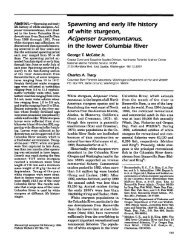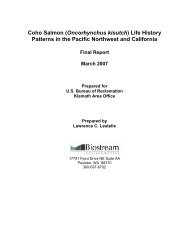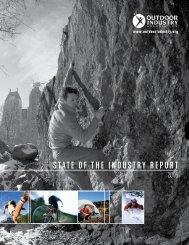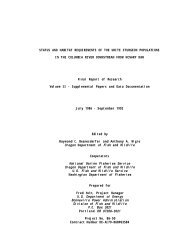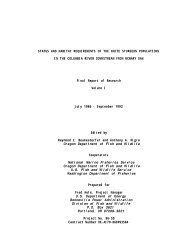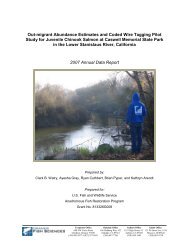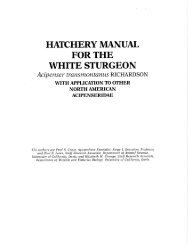IMF Technical Memorandum #3 - Cramer Fish Sciences
IMF Technical Memorandum #3 - Cramer Fish Sciences
IMF Technical Memorandum #3 - Cramer Fish Sciences
You also want an ePaper? Increase the reach of your titles
YUMPU automatically turns print PDFs into web optimized ePapers that Google loves.
S.P. <strong>Cramer</strong> & Associates, Inc.<br />
<strong>IMF</strong> <strong>Technical</strong> <strong>Memorandum</strong> <strong>#3</strong><br />
To:<br />
From: Steve <strong>Cramer</strong><br />
Zach Hymanson; Brent Walthall; Tim Quinn; Steve Macaulay;<br />
Steve <strong>Cramer</strong>; Sam Luoma; Russ Bellmer; 'Ronald M. Yoshiyama';<br />
Roger Guinee; Rick Sitts; Richard Denton; Paul Devries; Paul<br />
Cadrett; Pat Brandes; Michael. E. Aceituno; Michael Carlin; Lisa<br />
Holm; Lisa Culjis; Laura KingMoon; Kim Taylor; John Coburn; Joe<br />
Miyamoto; Pat Coulston; Jim White; Jim Smith; Elaine Archibald;<br />
Dudley Reiser; Doug Wallace; Doug Demko; Diana Jacobs; David<br />
Harlow; Dan Odenweller; Chuck Armor; Bruce Oppenheim; Alice<br />
Low<br />
CC: Pat Brandes; Randy Brown<br />
Date: January 28, 2004<br />
Testing the Winter-run Chinook Model:<br />
Smolt Survival Through the Delta<br />
Introduction<br />
This is the third <strong>Technical</strong> <strong>Memorandum</strong> to explain how we applied<br />
historical data to test how well past trends in spawner abundance of winter-run<br />
Chinook could be predicted by the Integrated Modeling Framework (<strong>IMF</strong>). The<br />
first memorandum related to historical spawner abundance and egg survival, and<br />
the second related to historical harvest rates. This memorandum describes our<br />
derivation of estimates since 1968 for juvenile survival during migration through<br />
the Delta. This is an important life stage to model for two reasons: 1) Delta<br />
survival is highly variable, and 2 ) many factors affecting that survival are human<br />
caused. Average survival of juvenile winter-run Chinook passing through the<br />
Delta has not been directly estimated by sampling in any year, so we needed to<br />
develop a means of accounting for variation in this survival when attempting to<br />
predict historical population trends. We will discuss the data and methods used,<br />
as well as their limitations.<br />
What Factors Affect Survival Through the Delta?<br />
There has been much analysis of factors influencing survival of juvenile fallrun<br />
Chinook passing through the Delta, but little on juvenile winter-run Chinook<br />
that pass in a different season and at a larger size. Accordingly, we derived our<br />
approach from studies with juvenile fall-run Chinook, and assumed they were<br />
applicable to winter-run chinook. We corroborated the reasonableness of that<br />
Testing the Winter-run Chinook Model 1/30/2004 Page 1 of 18
S.P. <strong>Cramer</strong> & Associates, Inc.<br />
assumption by comparing our results against those of Brandes (2003), who used<br />
data from tests during late fall and winter with coded-wire-tagged (CWT) juvenile<br />
Chinook near the Delta Cross Channel (DCC; see map in Figure 1).<br />
The most comprehensive analyses of data on factors affecting juvenile<br />
Chinook survival through the Delta have been those of Newman and Rice (1997)<br />
and Newman (2000). These works were later published as Newman and Rice<br />
(2002) and Newman (2003).<br />
Figure 1. Map of the lower Sacramento River and Delta.<br />
Testing the Winter-run Chinook Model 1/30/2004 Page 2 of 18
S.P. <strong>Cramer</strong> & Associates, Inc.<br />
Newman and Rice (1997) analyzed survival estimates from CWT recoveries<br />
of fall Chinook released above and below the DCC each spring between 1979<br />
and 1995. They found that temperature was the most influential environmental<br />
variable related to survival. Their work also indicated that flow, DCC gate<br />
position, and export-to-inflow ratios may also influence Delta migration survival,<br />
but those relationships were not statistically significant.<br />
The work of Newman (2000) improved on the work of Newman and Rice<br />
(1997) in estimating Delta survival and further isolated factors correlated with<br />
survival. Newman and Rice (1997) conducted their analyses on trawl recoveries<br />
at Chipps Island of CWT-marked Chinook, and used catch/fish released as an<br />
index of survival. Thus, variation in trawl efficiency would have added error to<br />
the index. Newman (2000) advanced the analysis by directly estimating Delta<br />
survival from recoveries of paired CWT groups: groups released at the entry to<br />
the Delta were paired with groups released at the exit to the Delta. The paired<br />
analysis of Newman (2000) estimated survival through the Delta as a function of<br />
the difference in ocean recovery rates for fish released in the river near<br />
Sacramento compared to those released at Port Chicago or Benicia (Figure 1).<br />
Newman (2000) found that the majority of cases in which estimated survival was<br />
near 100%, flows exceeded 15,000 cfs and in all cases occurred only when<br />
release temperatures were less than about 65° Fahrenheit. In further analysis on<br />
the effects of covariates on survival Newman (2000) found:<br />
“Flow effect can be seen to have the largest effect: as flow increases from<br />
600 cfs to 15,000 cfs, survival increases from 0.37 to 0.67. The release<br />
temperature effect is sizeable as well, with 40% decrease in survival as<br />
temperature increase from 58 to 76 degrees Fahrenheit. At a moderate flow<br />
of 8,100 cfs, the export effects are also sizeable. As export/inflow increases<br />
from zero to 49% (within the historical range of export/inflow values when<br />
flow was around 8,100 cfs), survival rate declines 22%. The effect of the<br />
cross-channel gate being open is estimated to be roughly 18% decline in<br />
survival.”<br />
Newman (2003) compared results of his paired analysis with that of the<br />
earlier unpaired analysis (Newman and Rice 1997). He found that the positive or<br />
negative effect of each of the variables was similar between the two analyses,<br />
but the significance of each relationship was consistently stronger for the paired<br />
analysis. Flow had the strongest association with survival in the paired model,<br />
whereas temperature had the strongest effect in the unpaired model.<br />
Temperature still had a significant negative effect on survival in the paired model,<br />
but the magnitude of the effect was less. The effect of the exports was greater in<br />
the paired model.<br />
In his final analysis of paired CWT releases, Newman (2003) compared<br />
three statistical techniques for estimating environmental effects on survival, and<br />
concluded the hierarchical formulation was the most reliable. Thus, we used his<br />
hierarchical formulation in our modeling. Newman (2003) estimated coefficients<br />
for a number of factors that might affect smolt survival, but we used those factors<br />
Testing the Winter-run Chinook Model 1/30/2004 Page 3 of 18
S.P. <strong>Cramer</strong> & Associates, Inc.<br />
pertinent to our analysis and that had statistically significant effects on survival.<br />
Those factors for which we included coefficients estimated by Newman (2003)<br />
were: river inflow, river temperature, exports, DCC gate position, turbidity, and<br />
salinity (Table 1). Newman (2003) also found significant reductions in survival for<br />
fish released upstream at Sacramento rather than at Ryde, but we did not include<br />
this effect because the juvenile production (JPE) portion of our model already<br />
predicted survival to the point of Delta entry (JPE averages survival estimates<br />
from Battle Creek to various points representing Delta entry; Sacramento to<br />
Ryde). We also did not include the effect of size, because Newman (2003)<br />
showed that estimates of that coefficient changed substantially between model<br />
formulations.<br />
The equation we used to estimate survival through the Delta, based on<br />
coefficients estimated by Newman (2003) is as follows:<br />
Survival = -1.02 + 0.56*loge (Flow) – 0.56*River Temp. – 0.21*Exports +<br />
0.04*Turbidity + 0.23*Salinity – 0.60*Gate Position<br />
Where:<br />
Flow = Mean flow in cubic feet per second at Freeport.<br />
River Temp. = Mean temperature in Fahrenheit at Freeport<br />
Export flow = Combined export flow to the State and Federal pumps<br />
Turbidity = Turbidity of river in formazine turbidity units near Courtland<br />
Salinity = water salinity measured by conductivity, µmho/cm at<br />
Collinsville<br />
Gate Position = Average of daily positions of the Delta Cross channel gates<br />
where each day a value of 0 or 1 signaled both gates closed<br />
or open, respectively.<br />
Newman (2003) standardized all variables except the DCC position indicator<br />
using the following equation:<br />
Standardized Value = (Observation – Mean)/Standard Deviation<br />
The mean and standard deviations for each variable were those reported by<br />
Newman (2003) from the observations in the dataset for paired CWT releases.<br />
Testing the Winter-run Chinook Model 1/30/2004 Page 4 of 18
S.P. <strong>Cramer</strong> & Associates, Inc.<br />
Table 1. Coefficients for environment variables used to estimate winter-run Chinook Delta<br />
survival. Relationship presented is the hierarchical formulation in Table 5 of<br />
Newman (2003). These coefficients estimate the logistic transform of survival.<br />
Coefficients of all variables except the gate indicator are for standardized<br />
variables.<br />
Covariate ß SE<br />
Intercept -1.02 0.10<br />
loge (River Flow) 0.56 0.09<br />
River Temperature °F -0.56 0.07<br />
Export Flow -0.21 0.07<br />
Turbidity 0.04 0.10<br />
Salinity 0.23 0.07<br />
Gate Position Indicator -0.60 0.13<br />
The equation we used includes salinity, which Newman (2003) reported<br />
was highly correlated to flow (r = -0.79). Although the two variables are<br />
negatively correlated, they both have a positive effect on survival (coefficients are<br />
positive). The combination of these effects results in a non-linear relationship<br />
between predicted survival and flow, because increasing flow reduces salinity,<br />
which decreases the benefit of flow to survival. We determined the relationship<br />
between salinity and flow by regressing salinity at Collinsville since 2000, and<br />
Sacramento River inflow at Freeport. The data set was limited to observations<br />
taken between December and March, because this is the primary time period<br />
when winter Chinook pass through the Delta. There was a strong negative<br />
exponential decline in salinity as flow increased (p
Salinity at Collinsville (micro ohms)<br />
S.P. <strong>Cramer</strong> & Associates, Inc.<br />
12000<br />
10000<br />
8000<br />
6000<br />
4000<br />
2000<br />
0<br />
Relationship of Sacramento River Flow to Salinity<br />
y = 102,003*e (-0.0002*x)<br />
r 2 = 0.65<br />
0 20 40 60 80 100<br />
Flow at Freeport (1000s cfs)<br />
Figure 2. Relationship between Sacramento River flow and salinity in the Delta.<br />
How do the different variables drive the survival estimates?<br />
We analyzed the sensitivity of Delta survival estimates to<br />
environmental variables by varying one factor at a time. We examined the<br />
ranges for each variable that corresponded to the ranges in the dataset of<br />
Newman (2003). When we varied flow in this analysis, we concurrently<br />
changed salinity according to the equation presented in Figure 2. The<br />
sensitivity of temperature was not examined, because all temperatures in<br />
Newman’s (2003) data set exceeded the range of temperatures that<br />
juvenile winter-run Chinook will encounter when passing through the Delta<br />
in December through March. The lowest temperature in the dataset of<br />
Newman was 58 o F, which is near the upper boundary for optimal growth of<br />
juvenile Chinook in a natural setting. Thus, the dataset analyzed by<br />
Newman includes temperatures that ranged from the incipient lethal level in<br />
the mid 70 o ’s F, down to the optimum range for growth. There is little<br />
reason to expect that survival would continue to increase as temperature<br />
declined below 58 o F, given that this within the optimum range for growth.<br />
Therefore, we assumed there was no further benefit to smolt survival as<br />
temperature dropped below 58 o F (i.e. we assumed the temperature effect<br />
was the same as that at 58 o F).<br />
The effects of each of the variables on the estimated Delta survival<br />
Testing the Winter-run Chinook Model 1/30/2004 Page 6 of 18
S.P. <strong>Cramer</strong> & Associates, Inc.<br />
can be seen in Figure 3. The most interesting result was the influence of<br />
flow and salinity on survival. As flow increases from a minimum of 6,000<br />
cfs to 15,000 cfs survival decreases. Though flow has a positive effect on<br />
survival, increasing flow results in a decrease in salinity. Reductions in<br />
salinity cause decreases in survival. Only up to 15,000 cfs, do the effects of<br />
decreasing salinity out weight the positive effects of increasing flow.<br />
Salinity drops to near zero at flows above 20,000 cfs, and survival benefits<br />
of increasing flow begin to outweigh the effects of decreasing salinity at<br />
approximately 15,000 cfs. The relationships of the other variables to<br />
survival, as described by the Newman equation, are linear.<br />
Estimated Survival<br />
Estimated Survival<br />
70%<br />
60%<br />
50%<br />
40%<br />
30%<br />
70%<br />
60%<br />
50%<br />
40%<br />
30%<br />
0 20,000 40,000 60,000<br />
Flow (cfs)<br />
5 10 15<br />
Turbidity<br />
20 25<br />
0 2000 4000 6000 8000 10000<br />
Exports (cfs)<br />
0 0.2 0.4 0.6 0.8 1<br />
Gate Position<br />
Figure 3. Change in Delta survival predicted by the adapted Newman function used in the<br />
<strong>IMF</strong>. One variable was varied while others were held at their mean value<br />
observed during paired releases of CWTs analyzed by Newman (2003). The<br />
effect of flow includes a link of flow to salinity according to the equation in<br />
Figure 1.<br />
Testing the Winter-run Chinook Model 1/30/2004 Page 7 of 18
S.P. <strong>Cramer</strong> & Associates, Inc.<br />
The survival equation just described requires for any simulation that<br />
values for environmental variables be supplied for the time frame when<br />
juvenile winter-run Chinook pass through the Delta. Because timing of<br />
peak migration varied between years, we next needed to account for<br />
differences in timing of winter-run smolt passage through the Delta each<br />
year.<br />
When is Peak Migration Through the Delta?<br />
Two peaks in outmigration of winter-run Chinook have generally<br />
been apparent each year since 1995-96 from captures of juveniles in the<br />
screw traps at Knights Landing, the trawl net at Sacramento, and the trawl<br />
net at Chipps Island (Figure 4). In each year, the first significant peak in<br />
passage followed the first major increase in flow during late-fall, generally in<br />
November or December. Regardless of flow changes, migration also<br />
consistently peaked a second time in March or early April, which we<br />
assume corresponds to the peak timing of the physiological transition from<br />
parr to smolt (seawater adaptation).<br />
How was Survival of Two Migration Groups Modeled?<br />
We accounted for the dual emigration peak in our test simulation of<br />
historic conditions by predicting survival for both groups, and averaging the<br />
survivals of those two groups. This was equivalent to assuming that half of<br />
the smolts passed following the first peak in flow, and the other half passed<br />
in March. The true pattern of emigration would have varied substantially<br />
from this assumption, but we have yet to develop a more accurate method<br />
of predicting smolt migration timing. Timing of passage at Sacramento has<br />
only been monitored since 1995-96, so migration timing in prior years was<br />
predicted from flows measured at Freeport. We assumed that migration<br />
patterns between 1968 and 1994 were similar to those of 1995-2002, in that<br />
there would have been a spike in migration following the first peak flow of<br />
the season. Passage data during 1995-2002 showed that the initial spike in<br />
migration each season lasted between 5 and 18 days following the first<br />
peak flow. Consistent with that duration, we predicted survival during the<br />
first peak in migration by using the mean values for environmental variables<br />
during the 10 days following the first sharp increase in flow. Survival during<br />
the second peak in migration that was typically in March [please show the<br />
data that make these two emigration periods apparent to everyone] was<br />
predicted using means for environmental variables during the full month of<br />
March each year.<br />
Testing the Winter-run Chinook Model 1/30/2004 Page 8 of 18
Cumulative Number Recovered<br />
Cumulative Number Recovered<br />
Cumulative Number Recovered<br />
300<br />
250<br />
200<br />
150<br />
100<br />
50<br />
0<br />
80<br />
60<br />
40<br />
20<br />
0<br />
120<br />
90<br />
60<br />
30<br />
0<br />
S.P. <strong>Cramer</strong> & Associates, Inc.<br />
Number Recovered<br />
Number Recovered<br />
Number Recovered<br />
NUMBER OF OLDER JUVENILE CHINOOK MEASURED IN THE<br />
SACRAMENTO RIVER MIDWATER AND KODIAK TRAWLS<br />
50<br />
40<br />
30<br />
20<br />
10<br />
0<br />
50<br />
40<br />
30<br />
20<br />
10<br />
0<br />
50<br />
40<br />
30<br />
20<br />
10<br />
0<br />
1995/1996<br />
1 16 1 16 1 16 1 16 1 16 1 16 1 15 1 16 1 16 1 16 1 16 1 16 31<br />
AUG 95 SEP 95 OCT 95 NOV 95 DEC 95 JAN 96 FEB 96 MAR 96 APR 96 MAY 96 JUN 96 JUL 96<br />
1996/1997<br />
1 16 1 16 1 16 1 16 1 16 1 16 1 15 1 16 1 16 1 16 1 16 1 16 31<br />
AUG 96 SEP 96 OCT 96 NOV 96 DEC 96 JAN 97 FEB 97 MAR 97 APR 97 MAY 97 JUN 97 JUL 97<br />
1997/1998<br />
1 16 1 16 1 16 1 16 1 16 1 16 1 15 1 16 1 16 1 16 1 16 1 16 31<br />
AUG 97 SEP 97 OCT 97 NOV 97 DEC 97 JAN 98 FEB 98 MAR 98 APR 98 MAY 98 JUN 98 JUL 98<br />
Figure 4. Example of two peaks in outmigration of winter-run-sized Chinook (bars) captured in the<br />
Sacramento trawl during winter. Figures from Erin Chappell, DWR, Sacramento.<br />
Testing the Winter-run Chinook Model 1/30/2004 Page 9 of 18<br />
100<br />
80<br />
60<br />
40<br />
20<br />
0<br />
120<br />
100<br />
80<br />
60<br />
40<br />
20<br />
0<br />
100<br />
80<br />
60<br />
40<br />
20<br />
0<br />
Freeport Flows cfs*1000<br />
Freeport Flows cfs*1000<br />
Freeport Flows cfs*1000<br />
25<br />
20<br />
15<br />
10<br />
5<br />
0<br />
25<br />
20<br />
15<br />
10<br />
5<br />
0<br />
25<br />
20<br />
15<br />
10<br />
5<br />
0<br />
Water Temperature (C)<br />
Water Temperature (C)<br />
Water Temperature (C)
S.P. <strong>Cramer</strong> & Associates, Inc.<br />
Although river temperature was a key factor relating to passage<br />
survival in the data analyzed by Newman (2003), river temperatures during<br />
winter are nearly always lower than the lowest value (58°F) in the data set<br />
for fall Chinook used by Newman. Newman (2003) found that passage<br />
survival increased as river temperature decreased from 70°F to 58°F. It is<br />
doubtful that survival would have increased further as temperature dropped<br />
below 58°F, so we assumed the temperature effect at
S.P. <strong>Cramer</strong> & Associates, Inc.<br />
Table 2. Values for environmental variables used to predict Delta survival of winter-run Chinook smolts during the<br />
first peak (peak flow passage) and second peak (March) in outmigration, 1968-2002. Temperature was<br />
assumed to be less than 58ºF in all instances. “Peak” and “March” values are 10 and 31-day averages,<br />
respectively.<br />
Run Peak Flow Passage Conditions March Conditions<br />
Total<br />
Year Start 10 days Frpt. Q Exports Gates Salinity Turbidity Survival Survival Frpt. Q Exports Gates Salinity Turbidity Survival Survival<br />
1968-69 12-Dec 25,270 2,952 0.5 517 8.2 0.25 0.56 49,730 3,403 0.0 235 8.2 0.79 0.68<br />
1969-70 13-Dec 29,810 1,102 0.0 221 8.2 0.92 0.71 44,210 2,265 0.2 158 8.2 0.76 0.74<br />
1970-71 19-Nov 24,870 2,049 0.0 167 8.2 0.59 0.64 30,480 4,702 0.4 187 8.2 0.59 0.62<br />
1971-72 23-Dec 27,550 1,497 0.5 212 8.2 0.48 0.62 23,900 6,601 0.7 172 8.2 0.42 0.52<br />
1972-73 11-Nov 22,160 3,623 0.5 275 8.2 0.00 0.50 51,640 1,331 0.0 243 8.2 0.83 0.66<br />
1973-74 8-Nov 44,350 5,014 0.5 327 8.2 0.73 0.68 64,680 6,200 0.0 140 8.2 0.80 0.74<br />
1974-75 11-Nov 20,720 1,829 1.0 161 8.2 -0.21 0.45 50,940 6,061 0.2 172 8.2 0.73 0.59<br />
1975-76 11-Nov 21,500 7,842 1.0 190 8.2 -0.75 0.32 14,570 8,410 1.0 2,224 8.2 0.24 0.28<br />
1976-77 1-Jan 10,625 6,568 1.0 6,830 8.2 -1.10 0.25 6,573 3,724 1.0 7,281 8.2 0.20 0.22<br />
1977-78 16-Dec 17,270 8,664 1.0 7,595 8.2 -0.65 0.34 55,570 5,773 0.2 194 8.2 0.75 0.55<br />
1978-79 11-Jan 36,320 4,236 0.2 711 8.2 0.76 0.68 29,170 4,386 0.0 199 8.2 0.63 0.66<br />
1979-80 24-Dec 36,870 6,430 0.2 475 8.2 0.55 0.63 55,340 4,441 0.0 203 8.2 0.80 0.72<br />
1980-81 4-Dec 21,600 6,647 1.0 963 8.2 -0.58 0.36 24,510 4,862 0.0 254 8.2 0.58 0.47<br />
1981-82 12-Nov 29,246 5,064 0.3 5,414 8.2 0.64 0.66 62,810 10,410 0.0 159 8.2 0.72 0.69<br />
1982-83 18-Nov 41,510 5,231 0.0 127 8.2 0.92 0.71 78,290 5,429 0.0 189 8.2 0.84 0.78<br />
1983-84 11-Nov 52,120 925 0.3 161 8.2 1.44 0.81 31,430 6,905 0.0 202 8.2 0.60 0.71<br />
1984-85 8-Nov 23,580 8,186 0.6 677 8.2 -0.40 0.40 14,310 8,599 0.5 575 8.2 0.26 0.33<br />
1985-86 24-Nov 17,400 9,460 0.7 6,445 8.2 -0.61 0.35 74,980 3,219 0.0 194 8.2 0.86 0.61<br />
1986-87 4-Jan 15,200 6,290 0.0 1,523 8.2 -0.35 0.41 21,580 5,596 0.2 418 8.2 0.49 0.45<br />
1987-88 3-Dec 19,150 7,005 1.0 6,984 8.2 -0.40 0.40 11,350 8,479 1.0 5,791 8.2 0.22 0.31<br />
1988-89 24-Nov 17,240 8,795 0.9 4,580 8.2 -0.79 0.31 43,370 10,288 0.2 1,881 8.2 0.61 0.46<br />
1989-90 21-Oct 16,960 10,643 1.0 6,089 8.2 -0.96 0.28 12,870 10,611 1.0 5,279 8.2 0.21 0.24<br />
1990-91 none -- -- -- -- -- -- -- 25,760 9,794 0.3 2,975 8.2 0.47 0.47<br />
1991-92 6-Jan 13,346 8,611 1.0 7,205 8.2 -0.99 0.27 20,340 10,490 0.0 326 8.2 0.38 0.33<br />
1992-93 9-Dec 20,340 2,890 0.9 5,364 8.2 0.04 0.51 49,340 6,117 0.0 268 8.2 0.74 0.63<br />
1993-94 7-Dec 23,860 10,686 1.0 5,272 8.2 -0.59 0.36 13,460 4,311 0.0 459 8.2 0.41 0.38<br />
1994-95 4-Dec 20,660 6,132 0.5 4,782 8.2 -0.05 0.49 71,920 2,956 0.0 226 8.2 0.86 0.67<br />
1995-96 18-Dec 31,820 4,360 0.0 148 8.2 0.67 0.66 56,240 3,677 0.0 136 8.2 0.81 0.74<br />
1996-97 10-Dec 69,000 8,320 0.0 131 8.2 1.25 0.78 24,470 7,132 0.0 202 8.2 0.52 0.65<br />
1997-98 24-Nov 22,400 10,785 0.2 5,493 8.2 -0.19 0.45 63,830 2,507 0.0 262 8.2 0.85 0.65<br />
1998-99 23-Nov 33,680 1,654 0.0 134 8.2 1.01 0.73 56,840 7,223 0.0 167 8.2 0.75 0.74<br />
1999-00 11-Jan 18,410 9,146 0.6 4,522 8.2 -0.57 0.36 58,560 9,152 0.0 171 8.2 0.72 0.54<br />
2000-01 9-Jan 19,190 4,496 0.6 5,658 8.2 0.01 0.50 24,700 7,932 0.0 301 8.2 0.50 0.50<br />
2001-02 24-Nov 19,690 5,291 0.5 5,563 8.2 0.02 0.50 21,320 8,276 0.0 317 8.2 0.45 0.48<br />
2002-03 14-Dec 41,831 10,058 0.3 2,917 8.2 0.44 0.61 22,960 10,855 0.0 289 8.2 0.41 0.51<br />
Testing the Winter-run Chinook Model 1/30/2004 Page 11 of 18
S.P. <strong>Cramer</strong> & Associates, Inc.<br />
How do conditions during the paired CWT experiments analyzed by Newman<br />
compare to those during migration of winter-run smolts?<br />
The current Delta survival function used in the <strong>IMF</strong> was developed using paired<br />
CWT release groups of fall-run Chinook. Though this method uses the best available<br />
data on smolt survival through the Delta, environmental conditions during emigration of<br />
fall-run Chinook generally differ from those during emigration of winter-run Chinook.<br />
Some parameters applied in the winter Chinook model are outside the range of<br />
observations used by Newman (2003). Because of our concern for predicting survival<br />
when environmental factors were outside the range of values analyzed by Newman, we<br />
examined the frequency with which winter conditions fell outside the range of analyzed<br />
data. We compared frequency distributions for environmental variables in the dataset<br />
analyzed by Newman to those for the period of Delta passage by winter-run Chinook<br />
smolts during 1968-2001. These comparisons were precautionary, to help us<br />
understand the extent that conditions for which we were predicting survival overlapped<br />
with the conditions used to develop the prediction function.<br />
Sacramento River Flow<br />
Sacramento River flow at Freeport during emigration of CWT groups evaluated<br />
by Newman (2003) ranged from 6,085 to 50,800 cubic feet per second (cfs). The<br />
frequency distribution of flow data indicates that CWT groups were generally released at<br />
flows between 5,000 and 15,000 cfs, with most at flows of 12,500 to 15,000 cfs (Figure<br />
6). Few CWT groups were released at flows greater than 35,000 cfs (Figure 6), so the<br />
predicted increases in survival related to flows above 35,000 cfs should be accepted<br />
with caution. About one third of historic flows during winter-run smolt passage were<br />
greater than 35,000 cfs (Figure 4). We regard the survival effects of flow above 35,000<br />
as a critical uncertainty that needs testing.<br />
% of Observations<br />
45%<br />
40%<br />
35%<br />
30%<br />
25%<br />
20%<br />
15%<br />
10%<br />
5%<br />
0%<br />
Frequency Distribution of Flow Values<br />
2,500<br />
7,500<br />
12,500<br />
17,500<br />
25,000<br />
35,000<br />
45,000<br />
55,000<br />
65,000<br />
75,000<br />
85,000<br />
Testing the Winter-run Chinook Model 1/30/2004 Page 12 of 18<br />
Flow<br />
Newman<br />
Hindcast<br />
Figure 6. Frequency distributions of Sacramento River flows during the CWT releases analyzed<br />
by Newman (2003) compared to those used to predict historic values of Delta survival for<br />
winter-run Chinook smolts during 1968-2001.
S.P. <strong>Cramer</strong> & Associates, Inc.<br />
Water Temperature<br />
Water temperatures during the paired CWT releases analyzed by Newman<br />
(2003) ranged from 58°F to 76°F, while water temperatures during winter-run emigration<br />
(November through March) were nearly always
S.P. <strong>Cramer</strong> & Associates, Inc.<br />
% of Observations<br />
25%<br />
20%<br />
15%<br />
10%<br />
5%<br />
0%<br />
Frequency Distribution of Export Values<br />
1,000<br />
2,000<br />
3,000<br />
4,000<br />
5,000<br />
6,000<br />
7,000<br />
8,000<br />
9,000<br />
10,000<br />
11,000<br />
Exports (cfs)<br />
Newman<br />
Hindcast<br />
Figure 8. Frequency distribution of observed water export volumes in the dataset used by<br />
Newman (2003) and those used to predict historic values of Delta survival for winterrun<br />
Chinook smolts during 1968-2001.<br />
Salinity<br />
Salinity during emigration of CWT groups evaluated by Newman (2003) ranged<br />
from 160-12,873 µmhos, and was most often less than 1,000 µmhos. The same held<br />
true for historic values during outmigration of winter-run Chinook smolts. Thus, the<br />
coefficient for salinity in Newman’s function (Table 1) should be appropriate for winterrun<br />
Chinook.<br />
% of Observations<br />
70%<br />
60%<br />
50%<br />
40%<br />
30%<br />
20%<br />
10%<br />
0%<br />
Frequency Distribution of Salinity Values<br />
1,000<br />
2,000<br />
3,000<br />
4,000<br />
5,000<br />
6,000<br />
7,000<br />
8,000<br />
9,000<br />
10,000<br />
11,000<br />
12,000<br />
13,000<br />
Salinity (micro mohs)<br />
Newman<br />
Hindcast<br />
Figure 9. Frequency distribution of observed salinity in the dataset used by Newman (2003) and<br />
those used to predict historic values of Delta survival for winter-run Chinook smolts<br />
during 1968-2001. X-axis labels give upper bound of interval.<br />
Testing the Winter-run Chinook Model 1/30/2004 Page 14 of 18
S.P. <strong>Cramer</strong> & Associates, Inc.<br />
Alternative Evidence for Predicting Delta Survival in the Winter<br />
We checked the reliability of the Newman (2003) function for predicting Delta<br />
survival in the winter by comparing its predictions to analyses and modeling of Brandes<br />
(personal communication, USFWS, Stockton) that were based on field experiments at<br />
the Delta Cross Channel (DCC) with late-fall-run Chinook during November to January.<br />
CWT experiments to evaluate effects of the DCC have been conducted in the Delta<br />
during November- January each winter since 1995. Data from those experiments<br />
provided an opportunity to check how well the observed smolt survivals during winter fit<br />
the predictions of the Newman equation, given the actual conditions that existed at the<br />
time of the late-fall CWT experiments. The results of this comparison, as will be<br />
described, indicate that the Newman equation can be used to predict survival through<br />
the Delta in the winter.<br />
Experimental releases of late-fall Chinook near the DCC in November through<br />
January were not conducted so as to directly estimate overall of juvenile salmon<br />
survival through the Delta from Sacramento to Chipps Island (as the Newman equation<br />
does), but rather they provided ratios for expanded recovery rates in the Chipps Island<br />
trawl of fish passing through Georgiana Slough versus those passing down the main<br />
Sacramento River to Chipps Island. By making some simplifying assumptions, Pat<br />
Brandes (USFWS) was able to use the GS/Ryde recovery ratio in a five-step model to<br />
estimate survival from Sacramento to Chipps Island. Her model was based on the<br />
assumptions that (a) the proportion of juveniles following migration routes through the<br />
central Delta is equal to the proportion of Sacramento flow entering the central Delta,<br />
and that (b) Delta survival of juveniles continuing down the main stem Sacramento<br />
River to Chipps Island is constant at 80%. We compared the estimates from her model<br />
to predictions from the Newman equation to see if the results corroborated each other.<br />
The model by Brandes to estimate survival of juvenile Chinook migrating through<br />
the Delta in winter used the following steps:<br />
1. Because there was a limited number of tests performed with CWT groups, each<br />
at a discrete flow, Brandes needed first to quantify how survival varied across the<br />
continuous range of flows tested. To do this she regressed the GS/Ryde survival<br />
ratio from late-fall experiments on the export rates averaged for three days after<br />
release of each CWT group.<br />
2. The regression in step 1 was then used to estimate the average GS/Ryde<br />
survival ratio for a given winter based on the mean export level between<br />
December 1 and April 15 that winter.<br />
3. The proportion of smolts continuing down the main stem versus entering the<br />
Central Delta was assumed equal to the proportions of flow passing those two<br />
routes during the month of December.<br />
4. The actual survival from Ryde to Chipps Island was assumed to be 80%, which is<br />
in the range of direct estimates in the spring, as calculated by Newman (2003).<br />
5. Given the values calculated in steps 1-4, the survivals for the Interior Delta route<br />
Testing the Winter-run Chinook Model 1/30/2004 Page 15 of 18
S.P. <strong>Cramer</strong> & Associates, Inc.<br />
could be calculated and survivals from the two routes could be combined to<br />
estimate average survival through the Delta.<br />
The equations and data used to complete the preceding five steps are described<br />
in more detail here. Experiments using late fall hatchery fish from Coleman National<br />
<strong>Fish</strong> Hatchery were used to estimate survival index ratios between fish migrating from<br />
Ryde and through the mainstem Sacramento and Georgiana Slough migration through<br />
the interior Delta. Brandes found that GS:Ryde survival index ratios were negatively<br />
correlated to average exports three days after release of the experimental groups, as<br />
defined by the equation:<br />
GS:R = (3*10 -5 )*Exports + 0.4583<br />
Where:<br />
GS:R = Georgian Slough to Ryde survival index ratio<br />
This relationship was subsequently used in the Brandes model to estimate Delta<br />
migration survival via the equation:<br />
S = (SM(PM) + SI(PI))/100<br />
and<br />
SI = (G:R)* SM<br />
Where:<br />
S = Survival index of all migrants<br />
SM = Survival index of fish migrating through the mainstem (assumed to be 0.8)<br />
SI = Survival index of fish migrating through the interior Delta<br />
PM = Proportion of outmigrants migrating through the mainstem; assumed equal to the<br />
proportion of flow not diverted from the mainstem in December.<br />
PI = Proportion of outmigrants migrating through the interior Delta; assumed equal to the<br />
proportion of flow diverted from the mainstem in December.<br />
Brandes estimated Delta survival of late fall Chinook via this model using the percent of<br />
water diverted in December and the mean exports between December 1 and April 15<br />
for the migration years of 1995-96 to 2002-03. We compared the survival estimates of<br />
Brandes to Delta survival as estimated via the Newman equation under the same<br />
environmental conditions.<br />
Survival estimates of the two methods were strongly and significantly correlated<br />
(p
S.P. <strong>Cramer</strong> & Associates, Inc.<br />
flow, export flow, and DCC gate position. The corroboration of the two models lends<br />
support to assumptions made and relationships used within each model, and gives<br />
added credence to their respective results.<br />
Newman (2003) Survival<br />
0.9<br />
0.8<br />
0.7<br />
0.6<br />
0.5<br />
0.4<br />
0.3<br />
0.2<br />
y = 2.45x - 1.09<br />
R 2 = 0.76<br />
1995-96 through 2002-03<br />
0.55 0.60 0.65 0.70 0.75<br />
Brandes Survival<br />
Figure 10. Relationship between survival predictions by the methods of Brandes vs those of<br />
Newman for winter-run Chinook smolts passing through the Delta during the winters of<br />
1995-96 through 2002-03.<br />
Table 3. Environmental values used in the Brandes and Newman models, and the associated<br />
estimates of survival for winter-run Chinook smolts passing through the Delta.<br />
Brandes Newman<br />
Year % Diverted Survival Flow (cfs) Temp (F) Exports Gate Pos. Salinity Turbidity Survival<br />
1995-96 26 0.66 24,570
S.P. <strong>Cramer</strong> & Associates, Inc.<br />
Newman , K. 2000. Estimating and modeling survival rates for juvenile chinook salmon<br />
outmigrating through the lower Sacramento River using paired releases.<br />
Unpublished technical report for California Department of Water Resources.<br />
Contract No. B-81353.<br />
Newman, K. and J. Rice. 2002. Modeling the survival of chinook salmon smolts<br />
outmigrating through the lower Sacramento River system. Journal of the<br />
American Statistical Association, 97: 983-993.<br />
Newman, K. 2003. Modelling paired release-recovery data in the presence of survival<br />
and capture heterogeneity with application to marked juvenile salmon. Statistical<br />
Modelling, 3: 157-177.<br />
Testing the Winter-run Chinook Model 1/30/2004 Page 18 of 18



